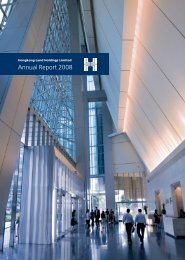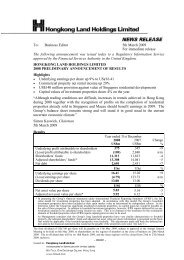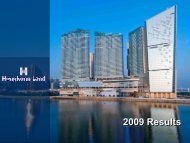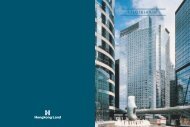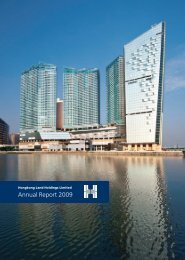Annual Report (in PDF) - Hongkong Land
Annual Report (in PDF) - Hongkong Land
Annual Report (in PDF) - Hongkong Land
Create successful ePaper yourself
Turn your PDF publications into a flip-book with our unique Google optimized e-Paper software.
Notes to the F<strong>in</strong>ancial Statements<br />
2 F<strong>in</strong>ancial Risk Management cont<strong>in</strong>ued<br />
a. F<strong>in</strong>ancial risk factors cont<strong>in</strong>ued<br />
i) Market risk cont<strong>in</strong>ued<br />
Group companies are required to manage their foreign<br />
exchange risk aga<strong>in</strong>st their functional currency. To manage<br />
their foreign exchange risk aris<strong>in</strong>g from future commercial<br />
transactions entities <strong>in</strong> the Group use forward foreign<br />
exchange contracts <strong>in</strong> a consistent manner to hedge firm<br />
and anticipated foreign exchange commitments. Forward<br />
foreign exchange contracts may also be used to hedge net<br />
<strong>in</strong>vestments <strong>in</strong> foreign operations where the currency<br />
concerned is anticipated to be volatile, the exposure of the<br />
Group is material and the hedg<strong>in</strong>g is cost effective. Foreign<br />
currency borrow<strong>in</strong>gs are required to be swapped <strong>in</strong>to the<br />
entity’s functional currency us<strong>in</strong>g cross currency swaps<br />
except where the foreign currency borrow<strong>in</strong>gs are repaid<br />
with cash flows generated <strong>in</strong> the same foreign currency. The<br />
purpose of these hedges is to mitigate the impact of<br />
movements <strong>in</strong> foreign exchange rates on assets and liabilities<br />
and the profit and loss account of the Group.<br />
Currency risks as def<strong>in</strong>ed by IFRS 7 arise on account of<br />
monetary assets and liabilities be<strong>in</strong>g denom<strong>in</strong>ated <strong>in</strong> a<br />
currency that is not the functional currency; differences<br />
result<strong>in</strong>g from the translation of f<strong>in</strong>ancial statements <strong>in</strong>to<br />
the Group’s presentation currency are not taken <strong>in</strong>to<br />
consideration. At 31st December 2007, there are no<br />
significant monetary balances held by Group companies<br />
that are denom<strong>in</strong>ated <strong>in</strong> a non-functional currency.<br />
Interest rate risk<br />
The Group is exposed to <strong>in</strong>terest rate risk through the<br />
impact of rate changes on <strong>in</strong>terest bear<strong>in</strong>g liabilities and<br />
assets. These exposures are managed partly by us<strong>in</strong>g natural<br />
hedges that arise from offsett<strong>in</strong>g <strong>in</strong>terest rate sensitive<br />
assets and liabilities, and partly through the use of derivative<br />
f<strong>in</strong>ancial <strong>in</strong>struments such as <strong>in</strong>terest rate swaps and caps.<br />
The Group monitors <strong>in</strong>terest rate exposure on a monthly<br />
basis by currency and bus<strong>in</strong>ess unit tak<strong>in</strong>g <strong>in</strong>to consideration<br />
proposed f<strong>in</strong>anc<strong>in</strong>g and hedg<strong>in</strong>g arrangements. The Group’s<br />
guidel<strong>in</strong>e is to ma<strong>in</strong>ta<strong>in</strong> between 40% and 60% of its gross<br />
debt and bank balances <strong>in</strong> fixed rate <strong>in</strong>struments. At 31st<br />
December 2007, 48% of the Group’s debt (2006: 41%)<br />
was hedged <strong>in</strong>to fixed rate with an average fixed rate tenor<br />
of 3.2 years (2006: 4.0 years). 40% of the Group’s cash<br />
(2006: 30%) was held <strong>in</strong> fixed rate with tenor of 1.6 years<br />
(2006: 2.4 years). The <strong>in</strong>terest rate profile of the Group’s<br />
borrow<strong>in</strong>gs after tak<strong>in</strong>g <strong>in</strong>to account hedg<strong>in</strong>g transactions<br />
are set out <strong>in</strong> Note 23.<br />
Cash flow <strong>in</strong>terest rate risk is the risk that changes <strong>in</strong> market<br />
<strong>in</strong>terest rates will impact cash flows aris<strong>in</strong>g from variable<br />
rate f<strong>in</strong>ancial <strong>in</strong>struments. Borrow<strong>in</strong>gs at float<strong>in</strong>g rates<br />
therefore expose the Group to cash flow <strong>in</strong>terest rate risk.<br />
The Group manages this risk by us<strong>in</strong>g forward rate<br />
agreements to a maturity of one year, and by enter<strong>in</strong>g <strong>in</strong>to<br />
<strong>in</strong>terest rate swaps and caps for a maturity of up to five<br />
years. Forward rate agreements and <strong>in</strong>terest rate swaps<br />
have the economic effect of convert<strong>in</strong>g borrow<strong>in</strong>gs from<br />
float<strong>in</strong>g rate to fixed rate, and caps provide protection<br />
aga<strong>in</strong>st a rise <strong>in</strong> float<strong>in</strong>g rates above a pre-determ<strong>in</strong>ed<br />
rate.<br />
Fair value <strong>in</strong>terest rate risk is the risk that the value of a<br />
f<strong>in</strong>ancial asset or liability and derivative f<strong>in</strong>ancial <strong>in</strong>strument<br />
will fluctuate because of changes <strong>in</strong> market <strong>in</strong>terest rates.<br />
The Group manages its fair value <strong>in</strong>terest rate risk by<br />
enter<strong>in</strong>g <strong>in</strong>to <strong>in</strong>terest rate swaps which have the economic<br />
effect of convert<strong>in</strong>g borrow<strong>in</strong>gs from fixed rate to float<strong>in</strong>g<br />
rate.<br />
At 31st December 2007, if <strong>in</strong>terest rates had been 100 basis<br />
po<strong>in</strong>ts higher/lower with all other variables held constant,<br />
the Group’s profit after tax would have been US$1 million<br />
higher/lower (2006: US$1 million lower/higher) and hedg<strong>in</strong>g<br />
reserve would have been US$9 million (2006: US$7 million)<br />
higher/lower, as a result of fair value changes to cash flow<br />
hedges. The sensitivity analysis has been determ<strong>in</strong>ed<br />
assum<strong>in</strong>g that the change <strong>in</strong> <strong>in</strong>terest rates had occurred at<br />
the balance sheet date and had been applied to the<br />
exposure to <strong>in</strong>terest rate risk for both derivative and nonderivative<br />
f<strong>in</strong>ancial <strong>in</strong>struments <strong>in</strong> existence at that date.<br />
The 100 basis po<strong>in</strong>t <strong>in</strong>crease or decrease represents<br />
management’s assessment of a reasonable possible change<br />
<strong>in</strong> those <strong>in</strong>terest rates which have the most impact on the<br />
Group, specifically the United States, Hong Kong and<br />
S<strong>in</strong>gapore rates, over the period until the next annual<br />
balance sheet date. In the case of effective fair value hedges,<br />
changes <strong>in</strong> fair value caused by <strong>in</strong>terest rate movements<br />
balance out <strong>in</strong> the profit and loss account aga<strong>in</strong>st changes<br />
<strong>in</strong> the fair value of the hedged item. Changes <strong>in</strong> market<br />
<strong>in</strong>terest rates affect the <strong>in</strong>terest <strong>in</strong>come or expense of nonderivative<br />
variable-<strong>in</strong>terest f<strong>in</strong>ancial <strong>in</strong>struments, the <strong>in</strong>terest<br />
payments of which are not designated as hedged items of<br />
cash flow hedges aga<strong>in</strong>st <strong>in</strong>terest rate risks. As a<br />
consequence, they are <strong>in</strong>cluded <strong>in</strong> the calculation of profit<br />
after tax sensitivities. Changes <strong>in</strong> the market <strong>in</strong>terest rate of<br />
f<strong>in</strong>ancial <strong>in</strong>struments that were designated as hedg<strong>in</strong>g<br />
<strong>in</strong>struments <strong>in</strong> a cash flow hedge to hedge payment<br />
fluctuations result<strong>in</strong>g from <strong>in</strong>terest rate movements affect<br />
the hedg<strong>in</strong>g reserves and are therefore taken <strong>in</strong>to<br />
consideration <strong>in</strong> the equity-related sensitivity calculations.<br />
26 <strong>Hongkong</strong> <strong>Land</strong>




